
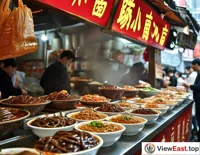

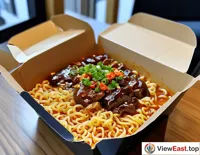
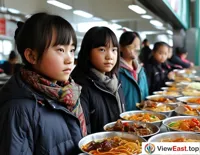
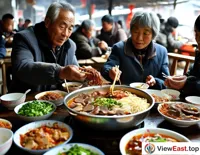

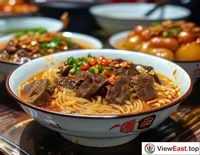
A: The Culture and Flavor Journey of Guizhou Changwang Noodles
Guizhou, a province located in the southwestern part of China, is known for its unique karst landscape and diverse ethnic cultures. Among the culinary treasures of Guizhou, Changwang noodles stand out for their vibrant colors, rich textures, and distinctive flavors. This dish is not only a part of the daily diet for Guizhou locals but also a reflection of Guizhou's culture.
Cultural Background
Changwang noodles originated in Guizhou, representing the locals' pursuit of taste and texture in food. In Guizhou, Changwang noodles often serve as breakfast or a quick energy-boosting snack, especially on cold days. A bowl of steaming hot Changwang noodles can dispel the chill and bring warmth and satisfaction.
Features and Taste
The specialty of Changwang noodles lies in the combination of "Changwang," which refers to the pairing of pork intestines and blood curd. The intestines, after careful cleaning and cooking, are free of any异味, while the blood curd is made from fresh pig's blood and has a smooth texture. The noodles are typically made from egg noodles, which are chewy. The entire bowl of noodles features a bright red soup that is spicy without being dry, fragrant without being greasy, and is a representative of Guizhou's spicy cuisine.
Appearance
A traditional bowl of Changwang noodles is topped with well-prepared pork intestines and blood curd, surrounded by green onions and cilantro, creating a visually appealing mix of red, white, and green.
Nutritional Value
The pork intestines and blood curd in Changwang noodles are rich in protein and iron, which help with blood replenishment and strengthening the body. The noodles provide abundant carbohydrates, an essential source of energy.
B: The Production Process of Guizhou Changwang Noodles
Introduction of Ingredients
The main ingredients include egg noodles, pork intestines, blood curd, mung bean sprouts, chili oil, Sichuan peppercorns, and minced garlic, ginger, and green onions.
Production Tools
The tools required are frying pans, pots for boiling, knives, mixing spoons, etc.
Ingredient Preparation
The pork intestines need to be thoroughly washed to remove impurities and odors.
The blood curd should be fresh and cut into bite-sized pieces.
Minced garlic, ginger, and green onions, as well as prepared chili and Sichuan peppercorns, are needed.
Cooking Steps
Cook the pork intestines and blood curd separately until the intestines are tender and the blood curd is set.
Boil the noodles until they are about 80% cooked, then remove and set aside.
Blanch the mung bean sprouts in the noodle boiling water.
Make the soup base by frying chili oil, Sichuan peppercorns, minced garlic, ginger, and green onions in hot oil until fragrant, then add water to make the soup.
Place the noodles, pork intestines, blood curd, and mung bean sprouts in a bowl and pour over the soup base.
Seasoning Techniques
The key to seasoning Changwang noodles lies in the preparation of chili oil and the use of Sichuan peppercorns, which together create the dish's spicy and savory characteristics. Adjust the spiciness and numbness according to personal taste.
Consumption Suggestions
Changwang noodles are best enjoyed while hot to experience the optimal flavor and texture. They can be accompanied by some refreshing side dishes, such as pickled vegetables or cold cucumber salad, to balance the spiciness.